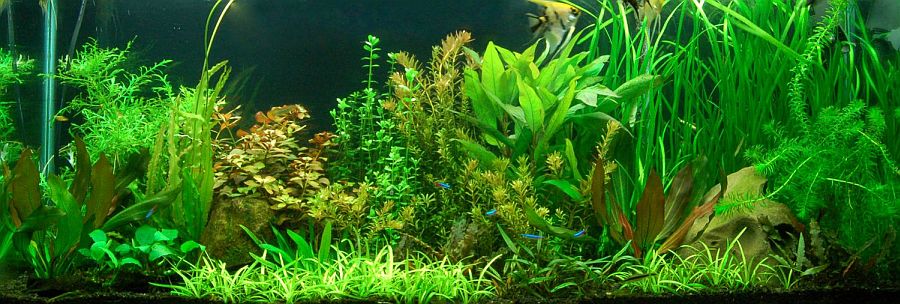








|

Testing water chemistry in the Planted Aquarium
This article addresses testing water chemistry in the planted aquarium and why we believe it is essential to any planted aquarium setup to insure success.
Matt Helgeson's five month aquarium pictured above and achieved by using our water chemistry adviceTesting Water Chemistry
To insure success in the planted aquarium you must test certain variables concerning water chemistry to help keep algae at bay and to provide an environment to insure optimum conditions for both the plants and your fish. What are those tests, why we need them, and how they work is the subject of this article. PH, KH (carbonate hardness), GH (general hardness), nitrates (macro that plants need, other form of this would be ammonium), and last but not least phosphate (another macro plants need) will be discussed.
PH
To give you a range PH should ideally be 6.8 to 7.2 for most community fish and plants. Neutral or 7.0 works best if you have the means to achieve this as fish and plants that come from alkaline regions (above 7.0) and fish and plants that come from acid regions (below 7.0) all do well together in a neutral (7.0) PH. We use a neutral PH in the nursery so that we can grow all species together. Your budget for your planted aquarium does play a part in how you can achieve the ideal 7.0 PH, and keep in mind that you can grow aquarium plants even below or above the PH range indicated above by adjusting certain other variables like CO2 (carbon dioxide), nutrient levels, etc.Ways to achieve a neutral PH:
1.) You can purchase an R/O (reverse osmosis, takes all of the minerals like calcium, magnesium, buffers, out of your tap water) unit. Then you would reconstitute (add back) the minerals with a powdered solution to achieve the GH, KH, and PH you desire, or you can combine your tap water with the R/O water to achieve this as well.
2.) You can purchase non - phosphate buffers like Seachem's Acid Buffer (drops PH) or Alkaline Buffer (raises PH) to add to your existing tap water to achieve the desired results.
3.) You can purchase R/O water at your local petshop or purchase distilled water at any grocery store and mix it with your tap water to achieve the desired result.
KH or Carbonate Hardness
Kh can be measured in terms of German Degrees in which we can work with a broad range of minimum 4 degrees, all the way to 8 degrees (again higher and lower values can work, 4 - 8 is the optimal range). If you measure those numbers and want to convert them to parts per million you would multiply those numbers by 17.9, or divide ppm's by 17.9 to get german degrees of hardness. KH (carbonate hardness needs to be a minimum of 3 if we inject CO2 gas to keep the PH from dropping too fast and stressing the fish, a lot of the plant species prefer a minimum of 5 KH, and so that is our target range in the nursery. At a neutral PH of 7.0 and KH of five, your CO2 level would be 14.7 mg/l, determined by a CO2 chart measuring KH against PH which is considered optimal for those values.GH or General Hardness
General Hardness is basically calcium and magnesium mineral levels. Plants and fish need both to survive! (hence you cannot use straight R/O water in your aquarium) In terms of German degrees I prefer to see it at 6-12 GH (multiply by 17.9 for ppm's), and again other values up or down will work. By achieving an 6 - 12 GH you will provide enough hardness minerals to benefit plants like Echinodorus (sword plants), and yet not be too hard to accomodate other softer water loving species. We maintain GH at 10 in the nursery. (remember when you top off evaporated water in your aquarium you must do it with R/O or distilled water, not tap water as you would be increasing the GH with tap water)
Nitrate
Nitrate or ammonium (this is the pre nitrate form that fish provide by their waste, urine, and is preferred form) is a macro that aquarium plants need. How do we achieve a level of nitrate or ammonium in the aquarium? By providing an adequate fish population and regular feeding to insure those levels are maintained. You can also supplement with additives like Seachem's liquid nitrogen if you find it difficult to achieve those levels with your fish population and feeding schedule. We like to see a range of 5 - 10 mg/l of nitrate in the aquarium to have a ratio of 10 - 1 nitrate to phosphate, all the way to 20 - 1 nitrate to phosphate. We maintain a level of approximately 10 - 1 or 5 mg/l of nitrate, our phosphate levels being .5 mg/l that is explained below in the phosphate column. If you allow the nitrate level to go to zero, algae can then take the existing phosphate and begin to grow in your aquarium (plants need every macro and micro nutrient to continue growing, if one macro or micro is missing then plants will slow and stop growth eventually).
Phosphate
Phosphate is a macro that aquarium plants need. How do we achieve an adequate level of phosphate in the aquarium? By feeding our fish the fish food provides the phosphates to insure those levels are maintained. You can also supplement with additives like Seachem's liquid phosphate if you find it difficult to achieve those levels with feeding your fish population and feeding schedule. We like to see a range of .3 - .5 mg/l of phosphate in the aquarium to have a minimum ratio of 10 - 1 nitrate to phosphate, if phosphate is .5 mg/l then nitrate would be 5 mg/l to achieve that 10 - 1 minimum. You can also have too much phosphate due to tap water that contains phosphate or overfeeding your fish which can then be corrected by using a phosphate sponge or water changes.
Links to Test Kits you need
PH low range test kit (6.2 - 7.4)
KH or Carbonate Hardness Test Kit
GH or General Hardness Test Kit
Phosphate Sponge with filter bag
This kit is our own planted aquarium master test kit and includes all of the above test kits at a discount over buying them individually!
Planted Aquarium Master Test KitAquatic Scapes
P.O. Box 1115
Faribault, MN 55021
Telephone: 507-331-5801
Fax: 507-384-3146
©Copyright Aquatic Scapes 2002-10
All rights reserved
